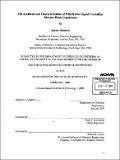The synthesis and characterization of polystyrene liquid crystalline siloxane block copolymers
Author(s)
Moment, Aaron J
DownloadFull printable version (8.997Mb)
Other Contributors
Massachusetts Institute of Technology. Dept. of Chemical Engineering.
Advisor
Paula T. Hammond.
Terms of use
Metadata
Show full item recordAbstract
Di block copolymers of polystyrene and side-chain liquid crystalline siloxanes have been prepared with a wide range of molecular weights (Mn total from 20,000 to 144,000) and liquid crystalline siloxane weight fractions (0.4 - 0.9). A new synthetic technique was developed to synthesize these materials, and is based on living anionic polymerization of a polystyrene-polyvinylmethysiloxane diblock copolymer followed by I the attachment of side-chain messages to the siloxane via hydrosilylation chemistry. Two different types of block copolymers were prepared, each series having a different mesogen attached to the siloxane block. Both mesogens were selected to result in a smectic C* siloxane LCP block. Increasing the rigidity of the mesogen led to stronger microphase segregation between the PS and LCP blocks, and to a higher Tg and LC clearing point for the LCP block. Samples with large LCP weight fractions (>0.8) and low Tg ( < -25°C) LCP blocks were elastomeric at room temperature, presumably because of the high molecular weight (80-130K) and low Tg (- -30°C) of the siloxane block. XRay measurements on these rubbery samples indicate that the mesogens orient perpendicular to the stretch direction. Mechano-optic effects were observed in these materials due to mesogen reorientation in a mechanical field. When stretched under crossed-polarizers, the optical textures could be dramatically altered, and in some cases light could be extinguished in particular regions of the film. As the mesogen choice and the block lengths were varied, four types of 7 morphologies were observed by TEM and SAXS: 1) alternating LCP and PS lamellae, 2) weakly ordered PS cylinders in a LCP matrix, 3) hexagonally packed PS cylinders in an LCP matrix, and 4) hexagonally packed LCP cylinders in a PS matrix. We found that the length, rigidity, and chemical structure of the mesogen greatly influence the extent of phase segregation, the nature of the block copolymer interface, and the stability of the resulting LC phase. The electro-optic properties of the LC block copolymers and their homopolymer analogues were studied, as the smectic C* phase is known to exhibit a fast bistable optical switching effect in the presence of an electric field. Electro-optic effects were found to be more facile in the homopolymers than in the block copolymers. Voltages as · high as ±30V/[mu]m did not effect mesogen reorientation in the block copolymers from room temperature up to the LC clearing point. The homopolymers, on the other hand, were all electro-optically active at voltages not exceeding ±10V/ [mu]m, suggesting that the block copolymer morphology severely restricts the motion of the mesogens in an applied electric field.
Description
Thesis (Ph.D.)--Massachusetts Institute of Technology, Dept. of Chemical Engineering, 2000. Includes bibliographical references.
Date issued
2000Department
Massachusetts Institute of Technology. Department of Chemical EngineeringPublisher
Massachusetts Institute of Technology
Keywords
Chemical Engineering.